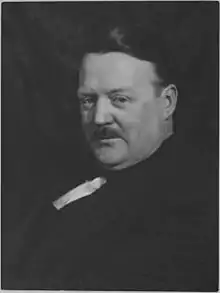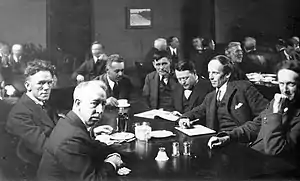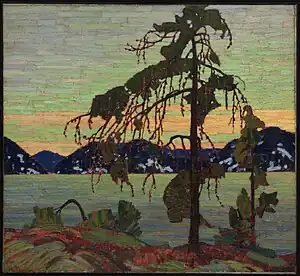Frank Johnston | |
|---|---|
 Frank Johnston, 1930 | |
| Born | Francis Hans Johnston June 19, 1888 |
| Died | July 9, 1949 (aged 61) Toronto, Ontario |
| Known for | painter |
Francis Hans Johnston (also known as Frank H. Johnston and as Franz Johnston) (June 19, 1888 – July 9, 1949)[1] was a member of the Group of Seven.
Life and career
Frank Johnston was born on June 19, 1888, in Toronto, the son of Hugh Hans and Mary Elizabeth (Roderick) Johnston.[2] He was educated at Central Technical School in Toronto, studying with Gustav Hahn, and the Central Ontario School of Art with William Cruikshank and George Agnew Reid.[3] In 1908, he joined Grip Ltd. as a commercial artist.[2] In 1910, he left for the United States where he studied art in Philadelphia and worked in commercial design in New York.[3] Upon his return to Toronto in 1915, he used his spare time from commercial art to pursue landscape painting, through sketching trips around Toronto. In 1918, he was commissioned by the Canadian War Memorials to record Canadian flying personnel training for overseas duty.[3]
In 1916, encouraged by Dr. James MacCallum, he travelled to Hearst, Ontario, to paint.[4] From 1918 on, he joined Lawren Harris and J.E.H. MacDonald on their journeys to Algoma.[3] His paintings from those years express a strong decorative interpretation of the landscape, but he often employed fast-drying tempera rather than oil paint.[5] Johnston's rate of production was such that in the 1919 Algoma show at the Art Gallery of Toronto he contributed sixty works - more than any other artist.
In 1920, he was invited to join the Group of Seven, but his association with it was brief. He did take part in the Group's first exhibition of 1920, but in the fall of 1920 he left Toronto to become Principal at the Winnipeg School of Art[6] and taught at the city's art school. He asserted his independence even more, having a large one-man show of 200 paintings at the T. Eaton Company Galleries in December 1920,[3] of which the Mail and Empire said:
The position of Frank H. Johnston, A.R.C.A. among local artists is unique. Mr. Johnston is always classed as one of the much discussed 'Group of Seven,' but he has never got out of touch with the picture lovers who cannot quite get the viewpoint of his ultra-radical companions....He has the secret of the living, vivid colouring of the Northland, and catches the feeling of the wild spaces.[7]
In January 1922 he held an exhibition at the Winnipeg Art Gallery that included 326 works.[8] He claimed that he had no disagreement with the group, only that he wanted to go his own way with regard to exhibition.
.jpg.webp)

In 1925, Johnston changed his name to the more exotic first name of 'Franz' Johnston.[3] By 1927, he was back in Toronto, working as the principal at the Ontario College of Art.[3] In later years, the artist's work demonstrated a return to a more classical style of landscape painting and revealed a strong fascination with the qualities of light, especially light on snow. This theme recurred in later works, in large narrative paintings of the 1930s and 1940s as well as more intimate examinations of a river valley, the bright blue of the water contrasting with snow-laden banks. His subjects range from the pastoral countryside of the Wyebridge area, to northern Quebec, and the Northwest Territories.[3] He had begun to hold regular solo exhibitions in the 1920s and his paintings found a great following among the public. Unlike many Canadian artists, Johnston was able to achieve considerable financial success in his own lifetime.[3]
He was made an associate member of the Royal Canadian Academy of Arts.[9] He was also a member of the Ontario Society of Artists. His work is in many public collections such as the National Gallery of Canada.[3]
He died in Toronto in 1949 and buried with fellow members of the Group of Seven at the McMichael Canadian Art Collection museum grounds in Kleinburg, Ontario. In 1969, he was given a Medal by the Royal Canadian Academy of Arts for being a member of the Group of Seven.[10]
Of his four children, two were artists: Francis-Anne Johnston and Paul Roderick. A retrospective of his work was organized at the Rothmans Art Gallery, Stratford (today called Gallery Stratford) in 1970.[3]
References
- ↑ "Noted Canadian Artist, Franz Johnston Dies". Edmonton Journal. July 11, 1949. Archived from the original on June 20, 2022. Retrieved June 20, 2022 – via Newspapers.com
 .
. - 1 2 "Artist/Maker Name "Johnston, Francis Hans"". Canadian Heritage Information Network. Government of Canada. Archived from the original on September 23, 2015. Retrieved September 23, 2015.
- 1 2 3 4 5 6 7 8 9 10 11 MacDonald 1979, p. 566-570.
- ↑ Fox, Ross (2010). Defiant Spirits: The Modernist Revolution of the Group of Seven. Vancouver: Douglas & McIntyre. pp. 284–285. Retrieved November 4, 2021.
- ↑ "Franz Johnston". National Gallery of Canada. Retrieved September 23, 2015.
- ↑ Marilyn Baker; Gallery 111 (1984). The Winnipeg School of Art: The Early Years. Univ. of Manitoba Press. p. 44. ISBN 978-0-88755-613-5. Retrieved January 22, 2013.
{{cite book}}: CS1 maint: numeric names: authors list (link) - ↑ "works". cowleyabbott.ca. Cowley Abbott Auction, Important Canadian & International Art, December 6th, 2023. Retrieved October 26, 2023.
- ↑ Hill, Charles C. "Article". cowleyabbott.ca. Cowley Abbott Auction. Retrieved July 3, 2023.
- ↑ "Members since 1880". Royal Canadian Academy of Arts. Archived from the original on May 26, 2011. Retrieved September 11, 2013.
- ↑ McMann, Evelyn (1981). Royal Canadian Academy of Arts. Toronto: University of Toronto Press. Archived from the original on October 11, 2022. Retrieved June 2, 2022.
Further reading
- Boulet, Roger (1982), The Canadian Earth, M. Bernard Loates, Cerebrus Publishing, ISBN 0920016103
- MacDonald, Colin S. (1979). A Dictionary of Canadian Artists, vol. 3 (Third ed.). Ottawa: Canadian Paperbacks Publishing. Retrieved October 12, 2020.
- Mason, Roger Burford (1998). A Grand Eye for Glory: A life of Franz Johnston. Toronto: Dundurn. Retrieved June 25, 2021.
External links
- Works by Frank Johnston at Faded Page (Canada)
- A brief history of the Canadian Group of Seven
- Frank Johnston at Find a Grave
- CBC Digital Archives - The Group of Seven: Painters in the Wilderness
- Ontario Plaques - Franz Johnston
